
Omana Regional Park
Encyclopedia
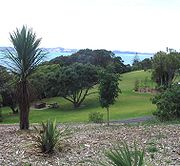
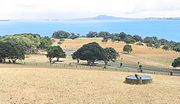
New Zealand
New Zealand is an island country in the south-western Pacific Ocean comprising two main landmasses and numerous smaller islands. The country is situated some east of Australia across the Tasman Sea, and roughly south of the Pacific island nations of New Caledonia, Fiji, and Tonga...
just before entering Maraetai township. Open 8am-5pm (winter) or 8.30pm (summer).
Overview
The park is located on a gently contoured knoll which rises 40 meters above sea level. From the highest point looking inland, visitors can see from Maraetai to the Beachlands settlements. Looking seaward, spectacular views can be had of the Hauraki Gulf.The eastern boundary is the Whitford-Maraetai road which is separated from view by a strip of mature native bush. There are 40.81 hectares of park of which about 20 hectares are used to graze sheep and the rest is used for recreational activities.
Omana is the home of the Omana Children's Day, held annually every March. The day is set aside for children to visit and pet the various farm animals.
The beach is covered with shells and suitable for swimming at high tide. The water is shallow, and sand lies under the shells for the children to enjoy. At low tide many shallow pools become exposed on the almost level rock foreshore which children find fascinating to explore.
There are picnic areas and barbecue facilities, making it an ideal place for a family outing. There is also a children's playground. Volleyball is often played on the grass area beside the beach where trees provide ample shade. Kayaking is also an interest for some people visiting the park. It has wheelchair access, drinking water from taps, campervan and camping sites (booking essential), even dogs can be walked on a leash around the perimeter track.
Families frequently explore the ‘perimeter track’ starting from the carpark area near the beach and following the coast, which allows great views over the Hauraki gulf towards Rangitoto and Waiheke Island
Waiheke Island
Waiheke Island is an island in the Hauraki Gulf of New Zealand, located about from Auckland.The island is the second-largest in the Hauraki Gulf after Great Barrier Island. It is the most populated, with nearly 8,000 permanent residents plus another estimated 3,400 who have second or holiday homes...
. Visitors will see beautiful Pohutukawa
Pohutukawa
The Pōhutukawa is a coastal evergreen tree in the myrtle family, Myrtaceae, that produces a brilliant display of red flowers made up of a mass of stamens. The Pōhutukawa is one of twelve Metrosideros species endemic to New Zealand...
trees clinging to the steep cliffs (forming the western boundary of the park) and enjoy seeing the sheep farm just over the fence. There are pleasant views along the northern and western areas from Omana Beach around to Kelly's Beach. During the walk children will enjoy patting the goats which are usually tied up in the ditch around the site of the Maori pa
(10 min's from the start).
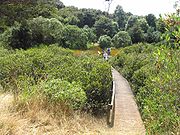
Mangrove
Mangroves are various kinds of trees up to medium height and shrubs that grow in saline coastal sediment habitats in the tropics and subtropics – mainly between latitudes N and S...
salt marsh of Te Puru Creek (which form the southern boundary of the park), followed by a gently undulating track through regenerating native bush where native birds can be seen and heard before returning to the car park beside the sea. Alternatively, there is a short walk (600m), through the middle of the farm where sheep can be seen grazing in a 'picture post card' rural setting.
Annual March Fun Day
The ARC celebrates a free entry and parking 'Children’s Day' at Omana Regional Park every year usually on the first Sunday of March. In March 2007, there was; live music, school kapa haka groups, pioneer activities, seashore safari, kite-making, orienteering for bigger kids, face painting, story telling, tractor and carriage rides, a BMXBMX
Bicycle motocross or BMX refers to the sport in which the main goal is extreme racing on bicycles in motocross style on tracks with inline start and expressive obstacles, and it is also the term that refers to the bicycle itself that is designed for dirt and motocross cycling.- History :BMX started...
obstacle course, a chance for city kids to experience life on the farm, pet Miniature Horses, sheep dog trials, sheep shearing
Sheep shearing
Sheep shearing, shearing or clipping is the process by which the woollen fleece of a sheep is cut off. The person who removes the sheep's wool is called a shearer. Typically each adult sheep is shorn once each year...
, German Shepherd display, gumboot and sponge throwing, food including a hangi, coffee, friendly farm animals and great picnic spots for families to sit under the trees. 2008 included icecreams, miniature ferris wheel, puppet shows and various information kiosks including one from the IRD. The date/times for the current year, find out 'What's on in Parks' from the ARC website.
The pa site
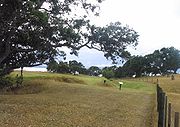
Pa (Maori)
The word pā can refer to any Māori village or settlement, but in traditional use it referred to hillforts fortified with palisades and defensive terraces and also to fortified villages. They first came into being about 1450. They are located mainly in the North Island north of lake Taupo...
were not permanently lived in, but were built close to kainga (villages) and were designed as safe places in case of attack. The depressions inside the pā are pits, once roofed over and used for storing Kūmara tubers, but now largely infilled but still visible.
The parks name - 'Omana'
The parks name ‘Omana’ is short for O-Manawatere ("the dwelling place of Manawatere"). According to legend, "This man Manawatere came from HawaikiHawaiki
In Māori mythology, Hawaiki is the homeland of the Māori, the original home of the Māori, before they travelled across the sea to New Zealand...
, he did not come in a canoe (waka
Waka (canoe)
Waka are Māori watercraft, usually canoes ranging in size from small, unornamented canoes used for fishing and river travel, to large decorated war canoes up to long...
), he glided over the ripples of the waves". The ARC information board beside the pa says he rode on the back of a taniwha
Taniwha
In Māori mythology, taniwha are beings that live in deep pools in rivers, dark caves, or in the sea, especially in places with dangerous currents or deceptive breakers...
.
History
Ngai Tai along with members of other Hauraki tribes, lived in the Omana park area for many generations. The park was part of William Fairburn's Maraetai Mission Station which included a small school for Maori from 1837 - 42. Omana was part of the mission farm, developed from 1837. The forest covering the park and surrounding area was felled for timber by European settlers who cleared the land for farming during the mid 1840's. Kauri felled in the Maraetai hills behind Omana was hauled by bullock teams down to the sea and then floated to mills in Auckland. The Omana park area was also dug for kauri gum and even prospected for gold and silver. In 1852 following the discovery of gold in Coromandel many searched the hills digging shafts wherever quartzQuartz
Quartz is the second-most-abundant mineral in the Earth's continental crust, after feldspar. It is made up of a continuous framework of SiO4 silicon–oxygen tetrahedra, with each oxygen being shared between two tetrahedra, giving an overall formula SiO2. There are many different varieties of quartz,...
veins could be located.
Birds
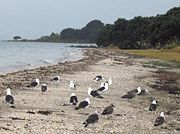
Pukeko (Porphyrio melanotus)
Pūkeko is the common name, derived from the Māori language, for the Purple Swamphen in New Zealand. The subspecies occurring there is Porphyrio porphyrio melanotus, which is also found elsewhere in Australasia, including, in eastern Indonesia, the Mollucas, Aru and Kai Islands, as well as in...
,
Kereru
Kereru
The New Zealand Pigeon or kererū is a bird endemic to New Zealand. Māori call it Kererū in most of the country but kūkupa and kūkū in some parts of the North Island, particularly in Northland...
, tui (bird)
Tui (bird)
The tui is an endemic passerine bird of New Zealand. It is one of the largest members of the diverse honeyeater family....
which appears almost black except for a white tuft under its chin, fantail
Fantail
Fantails are small insectivorous birds of southern Asia and Australasia belonging to the genus Rhipidura in the family Rhipiduridae...
, Grey Warbler
Grey Warbler
The Grey Gerygone , more commonly known in New Zealand as the Grey Warbler or Riroriro, is a species of insectivorous bird in the Acanthizidae family endemic to New Zealand.Its natural habitat is temperate forests....
, Red-billed Gull
Red-billed Gull
The Red-billed Gull , once also known as the Mackerel Gull, is a native of New Zealand, being found throughout the country and on outlying islands including the Chatham Islands and Sub-antarctic islands.The Māori name of this species is Tarapunga or Akiaki...
, Southern Black-backed Gull (see Kelp Gull
Kelp Gull
The Kelp Gull , also known as the Dominican Gull, breeds on coasts and islands through much of the southern hemisphere. The race L. d. vetula occurs around southern Africa, and nominate L. d...
), South Island Pied Oystercatcher
South Island Pied Oystercatcher
The South Island Oystercatcher or South Island Pied Oystercatcher is one of the two common oystercatchers found in New Zealand. Its name is often contracted to the acronym "SIPO" .-Description:...
and the closely related Variable Oystercatcher
Variable Oystercatcher
The Variable Oystercatcher is a species of wader in the Haematopodidae family.It is endemic to New Zealand. The Maori name is torea-pango. They are also known as 'red bills'....
(Haematopus unicolor), Pied Shag, Kingfisher
Kingfisher
Kingfishers are a group of small to medium sized brightly coloured birds in the order Coraciiformes. They have a cosmopolitan distribution, with most species being found in the Old World and Australia...
, and White-faced Heron
White-faced Heron
The White-faced Heron, Egretta novaehollandiae, also known as the White-fronted Heron, and incorrectly as the Grey Heron, or Blue Crane, is a common bird throughout most of Australasia, including New Guinea, the islands of Torres Strait, Indonesia, New Zealand, the islands of the Subantarctic, and...
. White-fronted Tern
White-fronted Tern
The White-fronted Tern is the most common tern of New Zealand. It rarely swims, apart from bathing, despite having webbed feet. The species is protected....
can be found resting on the greywacke outcrops which become visible at low tide (see pic in geology section).
Geology
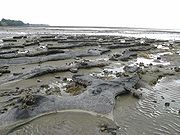
Greywacke
Greywacke or Graywacke is a variety of sandstone generally characterized by its hardness, dark color, and poorly sorted angular grains of quartz, feldspar, and small rock fragments or lithic fragments set in a compact, clay-fine matrix. It is a texturally immature sedimentary rock generally found...
(a harder basement sedimentary rock). The greywacke belongs to the Waiheke group. The softer more recent sandstone
Sandstone
Sandstone is a sedimentary rock composed mainly of sand-sized minerals or rock grains.Most sandstone is composed of quartz and/or feldspar because these are the most common minerals in the Earth's crust. Like sand, sandstone may be any colour, but the most common colours are tan, brown, yellow,...
is of the Waitamata group.
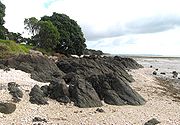
and west sides of the park. These softer, generally yellow-brown rocks are approximately 19-20 million years old and are made up of the Waitamata formation (East Coast Bays facies) of early Miocene (Late Otaian) age. Distortion and faulted dipping, of this once soft strata, can be seen both in the cliffs and in the small ridges of the rock platform extending out from the beach at low tide.

Holocene
Holocene
The Holocene is a geological epoch which began at the end of the Pleistocene and continues to the present. The Holocene is part of the Quaternary period. Its name comes from the Greek words and , meaning "entirely recent"...
sands (less than 7000 years old) form the flat area behind Omana Beach and at Te Puru Creek.
Simplified geological overview
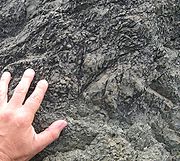
Gondwana
In paleogeography, Gondwana , originally Gondwanaland, was the southernmost of two supercontinents that later became parts of the Pangaea supercontinent. It existed from approximately 510 to 180 million years ago . Gondwana is believed to have sutured between ca. 570 and 510 Mya,...
into a deep trough in the sea floor. These deposits were kilometers thick and compressed, folded and heated became hard greywacke.
150 - 120 million years ago The hard greywacke was uplifted and became the first mountainous backbone of New Zealand. 120 - 70 million years ago the mountain ranges were eroded to a great degree. 35 – 15 million years ago the sea completely covered much of New Zealand. During this long quiet period, sediments were deposited over the old basement rock and gradually metamorphosed into sandstones. 15 – 5 million years ago The greywackes were again uplifted (Late Miocene
Miocene
The Miocene is a geological epoch of the Neogene Period and extends from about . The Miocene was named by Sir Charles Lyell. Its name comes from the Greek words and and means "less recent" because it has 18% fewer modern sea invertebrates than the Pliocene. The Miocene follows the Oligocene...
). This second set of earth movements, known as the Kaikoura Orogeny
Kaikoura Orogeny
The Kaikoura Orogeny is a New Zealand orogeny that has given birth to the Southern Alps. It began 25 million years ago along the Alpine Fault.In this orogeny the Southern alps are being formed because the Pacific Plate is being pushed up over the Australian Plate...
, elevated large fault-bounded blocks to form the horsts (upfaulted blocks of land) of the Hunua and Coromandel Ranges, and threw down the grabens (down-faulted blocks) of the Firth of Thames and Hauraki Gulf which Omana now overlooks.
Vegetation
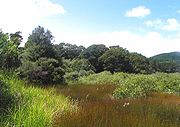
Pohutukawa
The Pōhutukawa is a coastal evergreen tree in the myrtle family, Myrtaceae, that produces a brilliant display of red flowers made up of a mass of stamens. The Pōhutukawa is one of twelve Metrosideros species endemic to New Zealand...
and grass areas, there is a southern patch of mature Tanekaha and a northern patch of Puriri
Puriri
Puriri is an evergreen tree endemic to New Zealand. -History:...
(ripe red berries) and Taraire
Taraire
Taraire, Beilschmiedia tarairi, is a tree of the Lauraceae family, endemic to the North Island of New Zealand. It is a common canopy tree in lowland forests north of Auckland, often growing in association with kauri , pōhutukawa , tawapou , and with pūriri on basalt rocks and soils...
. Other large trees include Rewarewa
Rewarewa
Knightia excelsa, Rewarewa in Māori, or New Zealand honeysuckle, is an evergreen tree endemic to the low elevation and valley forests of New Zealand's North Island and Marlborough Sounds and the type species for the genus Knightia....
, Mapou
Mapou
For the tree of the same name see MatipoMapou is a village in the northern part of the island of Mauritius. It serves the district capital of Rivière du Rempart. The island are linked with the coastal road as well as a road to Triolet and Port Louis. the village also has a post office, a primary...
, Kowhai
Kowhai
Kowhai are small, woody legume trees in the genus Sophora native to New Zealand. There are eight species, S. microphylla being the most common. Kowhai trees grow throughout the country and are a common feature in New Zealand gardens. Outside of New Zealand, Kowhai tend to be restricted to mild...
, Totara, Tree ferns, Cabbage trees, and Kahikatea. Kanuka
Kanuka
Kunzea ericoides is a tree or shrub which is restricted to Australia and New Zealand. Until 1983, Kānuka was classified as being in the genus Leptospermum.-Distribution and ecology:...
can be found on the slopes of the Te Puru creek (the estuarine Mangrove salt marsh).
Intertidal ecology
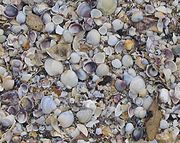
- Rocky shore platform with small pools at low tide on north and west of the park are occupied by small barnacles, rock oysters, Neptune's necklace (a sea weed) and tube worms.
- Sand and mudflats surrounding the shore platform contain cockles, pipi (Paphies australisPaphies australisPaphies australis or pipi is a bivalve mollusc of the family Mesodesmatidae, endemic to New Zealand.The pipi is a shellfish with a solid white, elongated symmetrical shell with the apex at the middle. It is covered by a thin yellow periostracum...
), crabs and PolychaetePolychaeteThe Polychaeta or polychaetes are a class of annelid worms, generally marine. Each body segment has a pair of fleshy protrusions called parapodia that bear many bristles, called chaetae, which are made of chitin. Indeed, polychaetes are sometimes referred to as bristle worms. More than 10,000...
worms. Because of the Cockle bed out in the sea, the Cockle shells wash up high on the beach during storms. The sand can be found underneath.
- Mangroves with Mud Snails Amphibola crenataAmphibola crenataAmphibola crenata is a species of air breathing snail with an operculum, a pulmonate gastropod mollusc which lives in a habitat that is intermediate between the land and the sea, not entirely terrestrial and not entirely marine...
, small mussels and barnacles.

